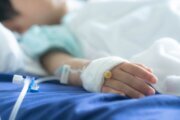No one ever wants to hear the words “you have breast cancer,” but the American Cancer Society estimates more than 266,000 Americans are likely to get that news in 2018. Part of what makes breast cancer such a fear-inducing diagnosis is the fact that it affects not just your physical health, but your financial well-being, too.
A recent report published by The Pink Fund, a Michigan-based national non-profit that provides financial assistance to breast cancer patients undergoing treatment, points to just how a big a financial impact having breast cancer can have. The survey found that 64 percent of people with breast cancer end up paying $5,000 or more out of pocket over the course of their treatment in medical-related expenses. These expenses may include copays, transportation to and from the hospital, meals out, parking at the hospital or even accommodations at out-of-town treatment centers — none of which are typically covered by insurance.
[See: A Tour of Mammographic Screenings During Your Life.]
The Pink Fund survey found that 47 percent of women are using their retirement accounts to pay for out-of-pocket expenses and 26 percent are paying with their credit cards. And some can’t make ends meet even with savings or credit; 41 percent of patients skipped medication or treatment to save money. When it comes to a choice between paying for treatment and covering basic living expenses, some patients are being forced to make the unenviable choice of feeding their families or risking their own survival.
“It’s a huge challenge,” says Molly MacDonald, founder of the Pink Fund. She says the organization conducted the survey — which received 587 responses from 1,000 people surveyed — to get a sense of the scope of the financial burdens breast cancer patients may face. “We know anecdotally it’s very challenging financially for patients, particularly with health care deductibles and copays being so high for so many.” She says this is layered on the fact that many people undergoing aggressive chemotherapy treatments must scale back their hours or stop working altogether. “That lost income compounds the financial challenges for them,” she says.”
The Pink Fund’s survey results echo those of another recent report produced in partnership between Xcenda, a health economics and market access consultancy group, and Family Reach, a non-profit alleviating the financial burden of cancer. Their white paper, ” Cancer Related Financial Toxicity and its Pervasive Effects on Patients and Families: Solving a National Health and Economic Crisis Hiding in Plain Sight,” describes the condition of cancer-related financial toxicity that affects nearly three-quarters of all adult cancer patients. Their report states that 72 percent of families reported losing more than 50 percent of their income after a cancer diagnosis and that up to 73 percent of adult cancer patients experience some sort of cancer-related financial toxicity. In this report, 39 percent of adult cancer patients postponed or did not fill drug prescriptions to reduce costs.
Although it makes sense that people without insurance or those who are poor are more likely to suffer financial hardships as a result of a cancer diagnosis, the problem cuts across all socioeconomic strata and occupational situations. “Even patients with good health insurance are experiencing hardships and financial stress,” says Kristine Flemister, president of Xcenda. The white paper reported that adults younger than 65 and families dealing with pediatric cancers are at higher risk of experiencing financial toxicity. Those who had poor financial health at the time of diagnosis and those who had less robust insurance plans also experienced financial toxicity more frequently than those with more expansive health coverage or greater financial means. Still, “that adults younger than 65 were at higher risk was surprising at first, but young adults have a high debt-to-income ratio with school loans and not being out there working for years, whereas an elderly patient has Social Security, Medicare and has maybe built up more assets,” she says.
[See: What Not to Say to a Breast Cancer Patient.]
MacDonald also cites student loan debt as a contributing factor to the financial burden many breast cancer patients experience. “We have a huge proportion of women being diagnosed under age 40. These women may be making decent money, but with college loans and a house payment, they’re already struggling financially and stretched before a cancer diagnosis.” She says the vast majority of respondents in the Pink Fund survey — 89 percent — had health insurance but still experienced financial difficulty as a result of a breast cancer diagnosis.
Carla Tardif, CEO of Family Reach, says her organization produced the white paper to shine a light on this little-mentioned aspect of cancer. “There’s a lot of shame and embarrassment around it. People don’t talk about finances anyway, so someone who’s fighting for their life through cancer, the finance is not something they’re talking about.”
Tardif wants people to know that there are programs and organizations that can help if you’re experiencing financial hardships as a result of cancer. Both Family Reach and the Pink Fund may be able to help depending on your situation. The Pink Fund offers 90 days’ coverage of bills for individuals who meet certain criteria. Tardif says Family Reach partners with 330 hospitals to train social workers to help patients navigate the financial side of a cancer diagnosis. And in some cases, they will pay patient’s bills directly for a period of time. And there are other organizations out there and programs at many hospitals across the country that can offer financial assistance if you need it — you just have to ask.
No matter what your financial situation prior to diagnosis, MacDonald recommends meeting with a financial planner or a liaison to the hospital’s billing department as soon as possible to work out a payment plan that’s reasonable and manageable. “For the 26 percent [of patients who are] putting it on a credit card, that is a complete no-no. Know that you can negotiate a payment plan that doesn’t charge you any interest with the health care system. It’s not going to collections as long as you honor that, and it’s based on your ability to pay. If someone tries to pressure you to pay on credit, say, ‘No, I want to speak with a financial counselor,’ and get the arrangement in writing.”
In addition, MacDonald recommends reducing spending where you can. When she was facing foreclosure and bankruptcy as a result of her own breast cancer diagnosis in 2005, she says she cut her kids’ hair and groomed the dog herself to save some money. “Look around at your house and see what you don’t need. What can you sell?”
Part-time work may also be an option worth exploring, particularly if it’s a work-from-home gig. And she says “if you have to, your retirement account is savings. If you’re young enough, you can make that up later.” If you’ve lost your income but still own a home, you may want to consider selling it and renting a house or apartment until treatment is over and you’re back to work. The bottom line is: “Think about how can you paste together enough resources to get through.”
Tardif encourages everyone to consider what you’d do if cancer comes calling someday. “If cancer is in your future, know that this is part of it. Know that finances will come into play and know that you have options. Know that you need to speak up and know that there is no shame. Know that 73 percent of adult patients will experience this. But there is help out there. There are resources that you can tap into.” She says you should start by speaking with the social worker on your care team as soon as possible after diagnosis to find out what resources are available. She urges patients to speak up early rather than waiting until they’ve reached a breaking point before asking for help.
[See: 7 Innovations in Cancer Therapy.]
MacDonald suggests that planning for a health crisis should be on par with planning for retirement or saving for a vacation — it should just be part of your financial resiliency plan. She says taking out a disability insurance policy for yourself, either through your job or independently, is the first thing you should do, preferably when you’re a young person who has no health problems. Having that safety net down the road if you need it may turn out to be a really helpful thing
In the end, all these strategies may help you avoid the worst situation — declaring bankruptcy, which the Family Reach white paper found was linked to a 79 percent greater risk of early mortality. “This is a national health crisis that’s hidden in plain sight. We need to do more to elevate awareness and alleviate the critical burden that’s placed on these cancer patients. My hope is that patients can focus on the fight to beat cancer instead of being so subsumed with this financial stress. They need to put their emotional energy and thought into being a fighter and beating that cancer,” Flemister says.
More from U.S. News
A Tour of Mammographic Screenings During Your Life
7 Innovations in Cancer Therapy
What Not to Say to a Breast Cancer Patient
What’s the Financial Cost of Breast Cancer? originally appeared on usnews.com







